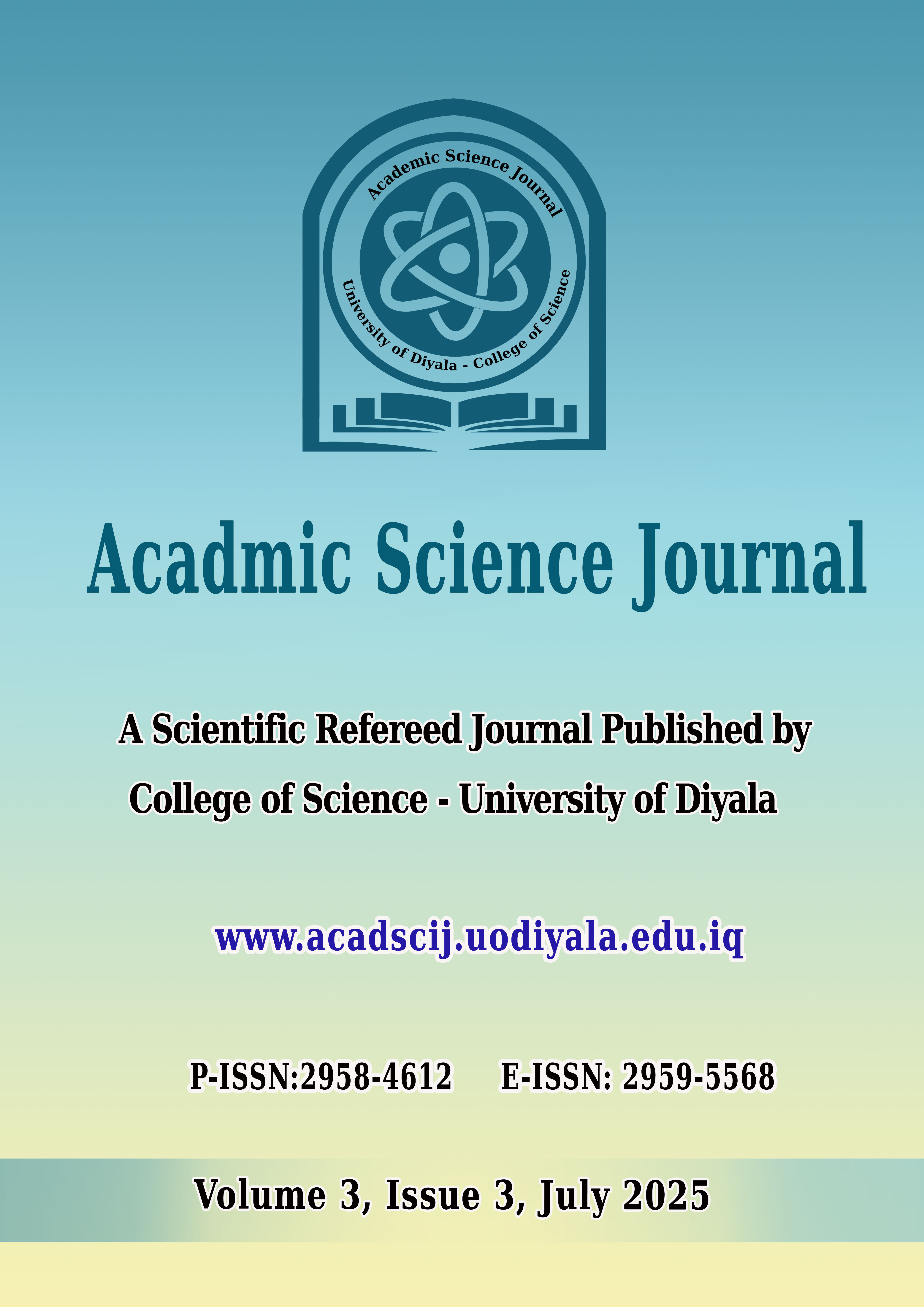Removing Manganese and Chromium from Drinking Water using Tannin-based biosorbents
DOI:
https://doi.org/10.24237/ASJ.03.03.876AKeywords:
Drinking water, Acacia nilotica, Heavy metals, TanninAbstract
Water is a vital source, essential for whole aspects of humanity and ecosystem existence. Unique of the greatest commanding ecological problems currently is earth water pollution among the extensive variety of pollutants affecting water incomes, heavy metals cause-specific anxiety due to their robust poisonousness even with little attentions. This study was designed for the synthesis of condensed tannin resin from leaves of the Acacia nilotica plant to remove heavy metals manganese and chromium from drinking water samples collected from Alrazi station for drinking water production in Alrazi Street, Baqubah, Iraq. Water sample treatment with condensed tannin resin was taken every ten minutes for a full hour to measure the amount of removing heavy metals. The results showed that condensed tannin resin was the most efficient in removing heavy metals manganese and chromium. The concentration of manganese recorded the following values 0.041, 0.038, 0.034, 0.032, 0.029 and 0.029 respectively, every ten minutes for a full hour with removing rate 39.6% compared with the value of control sample recorded 0.048, While the concentration of chromium recorded the following values 0.012, 0.010, 0.008, 0.007, 0.005 and 0.005 respectively every ten minutes for a full hour with removing rate 70.6% compared with the value of control sample recorded 0.017. The study of the adsorption kinetics of heavy metals manganese and chromium for both uptake capacity of heavy metal by condensed tannin resin and reach equilibrium was at a fixed time for each mineral above. The condensed tannin resin extracted from leaves of the Acacia nilotica plant was efficient in removing heavy metals manganese and chromium from drinking water.
Downloads
References
•[1] K. Mohankumar, Heavy Metal Contamination in Groundwater around Industrial Estate vs Residential Areas in Coimbatore, India, JOURNAL OF CLINICAL AND DIAGNOSTIC RESEARCH, (2016), DOI(https://doi.org/10.7860/jcdr/2016/15943.7527)
[2] A. Masih, and A. P. Sergeev, Heavy Metal Contamination Assessment in Near Surface Soils: A Case Study from Subarctic Region of Russia, IOP Conference Series: Earth and Environmental Science, 167, 012023(2018), DOI(https://doi.org/10.1088/1755-1315/167/1/012023)
[3] J. Binkley, and J. A. Simpson, Heavy metals in wastewater treatment processes, Handbook of Water and Wastewater Microbiology, 597–610(2003), DOI(https://doi.org/10.1016/b978-012470100-7/50036-4)
[4] N. M. Isa, A. Z. Aris, W. Y. Lim, W. N. A. W. Sulaiman, and S. M. Praveena, Evaluation of heavy metal contamination in groundwater samples from Kapas Island, Terengganu, Malaysia, Arabian Journal of Geosciences, 7(3), 1087–1100(2013), DOI(https://doi.org/10.1007/s12517-012-0818-9)
[5] M. A. Momodu, C. A. Anyakora, Heavy metal contamination of groundwater: The Surulere case study, Research Journal Environmental and Earth Sciences, 2(1), 39-43(2010).
[6] M. K. Anuja Ashok Bhatt, Removal of Heavy Metals from Water (Cu and Pb) Using Household Waste as an Adsorbent, Journal of Bioremediation & Biodegradation, 06(1), (2015), DOI(https://doi.org/10.4172/2155-6199.1000269)
[7] F. Fu, and Q. Wang, Removal of heavy metal ions from wastewaters: A review, Journal of Environmental Management, 92)3(, 407–418)2011(, DOI)https://doi.org/10.1016/j.jenvman.2010.11.011(
[8] H. Malassa, M. Hadidoun, M. Al-Khatib, F. Al-Rimawi, and M. Al-Qutob, Assessment of Groundwater Pollution with Heavy Metals in North West Bank/Palestine by ICP-MS, Journal of Environmental Protection, 05)01(,54–59)2014(, DOI)https://doi.org/10.4236/jep.2014.51007(
[9] S. Chakrabarty, and H. P. Sarma, Heavy metal contamination of drinking water in Kamrup district, Assam, India, Environmental Monitoring and Assessment, 179)1–4(,479–486)2010(, DOI)https://doi.org/10.1007/s10661-010-1750-7(
[10] T. K. Boateng, F. Opoku, S. O. Acquaah, and O. Akoto, Pollution evaluation, sources and risk assessment of heavy metals in hand-dug wells from Ejisu-Juaben Municipality, Ghana, Environmental Systems Research, 4)1(, (2015), DOI(https://doi.org/10.1186/s40068-015-0045-y)
[11] A. J. Bora, and R. K. Dutta, Removal of metals (Pb, Cd, Cu, Cr, Ni, and Co) from drinking water by oxidation-coagulation-absorption at optimized pH, Journal of Water Process Engineering, 31, 100839(2019), DOI(https://doi.org/10.1016/j.jwpe.2019.100839)
[12] K. C. K. Lai, and I. M. C. Lo, Removal of Chromium (VI) by Acid-Washed Zero-Valent Iron under Various Groundwater Geochemistry Conditions, Environmental Science & Technology, 42)4(,1238–1244)2008(, DOI)https://doi.org/10.1021/es071572n(
[13] K. KRISHNANI, X. MENG, C. CHRISTODOULATOS, and V. BODDU, Biosorption mechanism of nine different heavy metals onto biomatrix from rice husk, Journal of Hazardous Materials, 153)3), 1222–1234(2008), DOI(https://doi.org/10.1016/j.jhazmat.2007.09.113)
[14] N. K. Lazaridis, and D. D. Asouhidou, Kinetics of sorptive removal of chromium(VI) from aqueous solutions by calcined Mg–Al–CO3 hydrotalcite, Water Research, 37(12), 2875–2882, (2003), DOI(https://doi.org/10.1016/s0043-1354(03)00119-2)
[15] X. Zhou, and G. Du, Applications of Tannin Resin Adhesives in the Wood Industry, Tannins - Structural Properties, Biological Properties and Current Knowledge, (2020), DOI(https://doi.org/10.5772/intechopen.86424)
[16] X. Huang, Y. Wang, X. Liao, and B. Shi, Adsorptive recovery of Au3+ from aqueous solutions using bayberry tannin-immobilized mesoporous silica, Journal of Hazardous Materials, 183(1–3), 793–798(2010), DOI(https://doi.org/10.1016/j.jhazmat.2010.07.096)
[17] N. Konai, Aningre ( Aningeria spp.) tannin extract characterization and performance as an adhesive resin, Industrial Crops and Products, 77, 225–231(2015), DOI(https://doi.org/10.1016/j.indcrop.2015.08.053)
[18] X. Huang, X. Liao, and B. Shi, Hg(II) removal from aqueous solution by bayberry tannin-immobilized collagen fiber, Journal of Hazardous Materials, 170( 2–3), 1141–1148(2009), DOI(https://doi.org/10.1016/j.jhazmat.2009.05.086)
[19] V. U. Kavitha, and B. Kandasubramanian, Tannins for wastewater treatment, SN Applied Sciences, 2(6), (2020), DOI(https://doi.org/10.1007/s42452-020-2879-9)
[20] P. Meethale Kunnambath, and S. Thirumalaisamy, Characterization and Utilization of Tannin Extract for the Selective Adsorption of Ni (II) Ions from Water, Journal of Chemistry, 2015, 1–9(2015), DOI(https://doi.org/10.1155/2015/498359)
Downloads
Published
Issue
Section
License
Copyright (c) 2025 CC BY 4.0

This work is licensed under a Creative Commons Attribution 4.0 International License.












